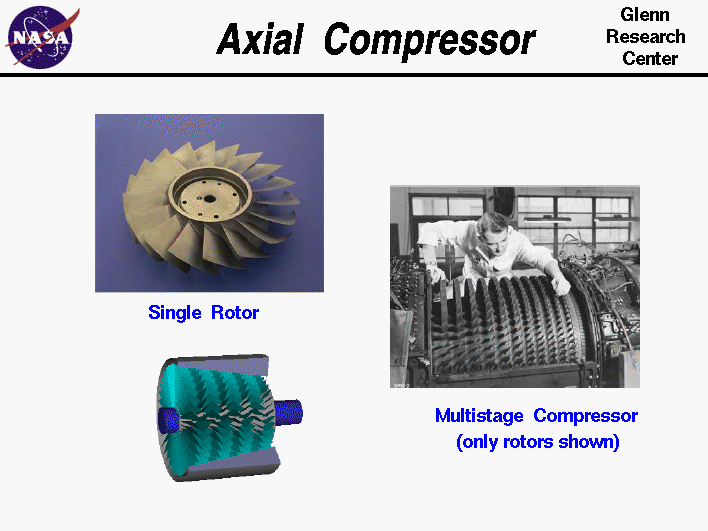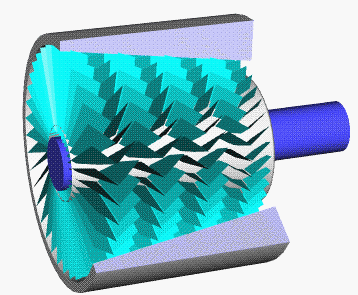
Most modern passenger and military aircraft are powered by
gas turbine engines, which are also called
jet engines. There are several different types
of jet engines, but all jet engines have some parts
in common. All jet engines have a compressor
to increase the pressure of the incoming air
before it enters the burner.
Compressor performance
has a large influence on total engine
performance.
There are two main types of compressors used in modern jet
engines; axial compressors are discussed on this slide,
and centrifugal
compressors are discussed on another slide. In the axial
compressor, the air flows parallel to the axis of rotation. The
compressor is composed of several rows of airfoil cascades. Some of
the rows, called rotors, are connected
to the central shaft and rotate at high speed. Other rows, called
stators, are fixed and do not rotate. The job of the stators
is to increase pressure and keep the flow from spiraling around the
axis by bringing the flow back parallel to the axis. In the figure on
the right, we see a picture of the rotors of an axial compressor. The
stators of this compressor are connected to the outer casing, which
has been removed and is not shown. At the upper left is a picture of
a single rotor stage for a different compressor so that you can see
how the individual blades are shaped and aligned. At the bottom of
the figure is a computer generated figure of an entire axial
compressor with both rotors and stators. The compressor is attached
to a shaft which is connected to the power
turbine on the right end of the blue shaft.
Here is an animated version of the axial compressor:

How does an axial compressor work? The details are quite complex
because the blade geometries and the resulting flows are three
dimensional, unsteady, and can have important viscous
and compressibility effects. Each blade on a rotor or stator
produces a pressure variation much like the airfoil
of a spinning propeller. But unlike a
propeller blade, the blades of an axial compressor are close to one
another, which seriously alters the flow around each blade.
Compressor blades continuously pass through the wakes of upstream
blades that introduce unsteady flow variations. Compressor designers
must rely on wind tunnel testing and
sophisticated computational
models to determine the performance
of an axial compressor. The performance is characterized by the
pressure ratio across the compressor CPR, the rotational speed of
the shaft necessary to produce the pressure increase, and an
efficiency factor that indicates how much additional work is required
relative to an ideal compressor. There are additional important
compressor topics, like stall and surge, that will be added to these
pages in the future.
Activities:

Guided Tours
-
 Parts of a Jet Engine:
Parts of a Jet Engine:

-
 Compressor:
Compressor:

-
 Turbofans:
Turbofans:

Navigation ..

- Beginner's Guide Home Page
|
